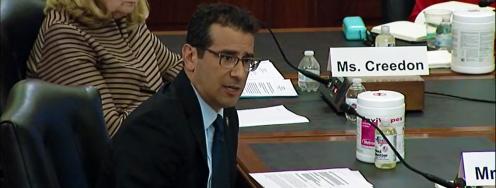President’s Nuclear Priorities at Odds with Administration’s Budget
On the radar: Experts decry nonpro budget cuts; Iran gives details on PMD; Progress seen on Iran nuclear negotiations; Getting ready for success with Iran; Some Israelis coming around on Iran negotiations; Some B52s get facelifts; Poor behavior amongst missileers leads to missile base spending boom; More on MOX; and Ballistic missile defenses are great for spending money, if not defending against missiles.
May 5, 2014 | Edited by Lauren Mladenka and Geoff Wilson
Priorities - “A group of 100 former officials, peace advocates and issue experts criticized the White House for planning to cut nuclear security funding next year,” writes Sebastian Sprenger in a piece for Global Security Newswire. “In a letter to President Obama, the mainly left-leaning critics argued that the fiscal 2015 budget request would signal a ‘major retreat’ in efforts to secure nuclear materials worldwide. Specifically, the experts lamented a planned reduction to the Global Threat Reduction Initiative of 25 percent, and cuts to the International Nuclear Materials Protection Program totaling 27 percent. Also affected: The Pentagon's Cooperative Threat Reduction budget, which is slated to be cut by 27 percent.”
--“The administration has said preventing terrorists from acquiring atomic material to build nuclear weapons, even in crude form, is a key thrust in the president's national security agenda. The letter states that “In your closing remarks ... at the 2014 Nuclear Security Summit in the Netherlands, you rightly stated that despite the progress made over the past four years, 'it is important for us not to relax, but rather accelerate our efforts ... [and] sustain momentum. The [fiscal 2015] budget request is out of sync with these objectives." Read the full story here. http://bit.ly/1mv13BC
--Read the letter here. http://bit.ly/1iihddO
Tweet - @insidedefense: House Committee Looks To Create Separate Fund For Ohio Replacement. Inside the Navy. (paywall) http://t.co/z4Wzhb5rPC
Providing information - “Iran has provided the U.N. nuclear watchdog with information about detonators with possible military applications, under an accord intended to allay concerns about Tehran's atomic activities,” writes Mehrdad Balali in Reuters. “Diplomats in Vienna, where the IAEA is based, last week told Reuters they did not know whether Iran had so far given the U.N. body the requested information about fast-functioning Exploding Bridge Wire (EBW) detonators, which can be used to help set off an atomic explosive device but also has civilian applications. It was one of seven measures Iran agreed three months ago to implement by May 15 under a step-by-step plan for the IAEA to gain more insight into the country's nuclear work, but the first directly related to the U.N. body's long-stalled bomb probe.” Read the full article here. http://reut.rs/1id7KZx
Optimism over talks - “Nuclear experts from Iran and six world powers are meeting in New York this week amid rising hopes that an agreement can be reached to limit Iran's ability to produce nuclear weapons before a July 20 deadline,” writes Edith Lederer for AP. “[Russia], the International Atomic Energy Agency and outside experts tracking the negotiations agree that the Iranians are cooperating, answering questions that they previously avoided and appear to want an agreement that ends crippling sanctions. Hopes for a deal were bolstered by news that international nuclear inspectors plan to visit two sites in Iran in the coming days, which an official said Sunday would fulfill demands made by the United Nations nuclear watchdog.” Full article here. http://abcn.ws/1kEVv6u
Preparing for success - With the prospects high for reaching an Iran nuclear deal by July 20, “we better prepare for what happens after a deal. As difficult as these negotiations have been and will continue to be in the weeks ahead, things will not get any easier when the parties return home to sell a final agreement to their respective hardliners,” write Jamal Abdi and Tyler Cullis in The National Interest. “Here in the United States, the ‘sell’ will be doubly difficult, as it is not just the rhetorical angst of the Iran-hawks on Capitol Hill that will need to be countered, but also the series of laws enacted by Congress that limit the President’s power to provide Iran necessary sanctions relief for a deal.”
--“Congress should provide the President with the requisite authorities to lift all nuclear-related sanctions,” say Abdi and Cullis. “This would balance two competing demands: Presidential flexibility and Congressional oversight. The President would have the flexibility to meet U.S. obligations to trade-in sanctions relief for Iranian nuclear concessions, and Congress would be well situated to take action should Iran be found in material breach of the agreement. No other solution is so well suited to satisfy inter-branch competition, all the while addressing the ultimate goal: Iran as a non-nuclear-weapon state.” Full piece here. http://bit.ly/Q6e49S
Coming around - “Some former U.S. officials and issue experts say Israel appears to have accepted Iran being allowed some degree of nuclear capability,” Global Security Newswire reports. “Al-Monitor cites one former U.S. official who participated in consultations with Israel last month as saying officials there seem to ‘understand that there is a need for a domestic, indigenous civil nuclear program’ if the Iranians are to satisfy their domestic opposition. Jerusalem officials instead have turned their attention to potential problems involved in policing any nuclear deal between Tehran and the the five permanent members of the U.N. Security Council plus Germany, the so-called ‘P-5+1’ group.” Full story here. http://bit.ly/1sbl9EH
Teaching an old bomber new tricks - “Some aging B-52 nuclear-capable bombers just returned to Air Force units, sporting upgraded and modern communications technology,” Global Security Newswire reports. “The aircraft are part of the service's $1.1 billion CONECT program, which stands for Combat Network Communications Technology. Equipping the bombers with new systems means crew members need no longer take down targeting data on paper during radio transmissions, as they have done for decades.”
--“Today's B-52s were first introduced into the service in the 1960s. Air Force officials hope upgrading the B-52 through its planned retirement in 2040 will help bridge the time until a new long-range strike bomber becomes available. A contract competition for that program is set to begin this fall… Global Strike Command chief Lt. Gen. Stephen Wilson told the magazine he envisions a new conventionally outfitted bomber aircraft becoming operational by 2025. It should be capable of carrying nuclear weapons by 2027.” Full story here. http://bit.ly/1g2Axfd
Improved quality of life - “Less than four months after drug and cheating investigations were announced at Malmstrom Air Force Base, a number of changes have already been implemented,” writes Jenn Rowell in The Great Falls Tribune. “Malmstrom has received $2.86 million for upgrades identified through the program, plus $1 million for quality-of-life improvements… The quality-of-life improvements at Malmstrom include updated kitchen equipment and working gear for the missile alert facilities, as well as reopening the base pool and resurfacing the gym floor in the fitness center. Other improvements include: wall lockers at the missile alert facilities, computer chairs, fire station mattresses and box springs, paint and security cameras for dormitories, carpet steam cleaners, light bulbs, pool table equipment, computers and more.”
--“[Air Force officials] are still looking at other incentive options such as incentive pay and deployment credit for time in the missile field. ‘Sometimes it’s the little things,’” said Maj. Gen. Jack Weinstein, commander of 20th Air Force, which oversees Malmstrom. Full article here. http://gftrib.com/Q69jxf
MOX questions - “MOX is a mix of oxides of uranium and plutonium that can be used as fuel for commercial nuclear reactors. It removes some plutonium from the sticky fingers of terrorists. Sound good? Yes, until the cost of doing this soared,” writes Victor Reilly in The Augusta Chronicle. “First, our plutonium problem. With welcome reductions in our nuclear arsenal, we now have about a hundred tons of plutonium in storage. In the wrong hands, less than 20 pounds of it could make a nuclear bomb. That would be a catastrophe. We must store it securely for decades. Savannah River Site would be logical for this job, with its huge area and a staff experienced in handling plutonium. This would provide good jobs that the governor should have jumped at.”
--“MOX’s design capacity is to disable one ton of plutonium per year, so if MOX were the way to work it off, it would take more than a hundred years. A stock of one ton requires as much protection as for 100 tons. With the huge increase in fixed costs from construction, would it be profitable? If we plan to cancel the program, we would end up writing off the sunk costs, so why not do it anyway? Would it then be profitable? If MOX fuel can’t be sold at a profit, why continue with it? In summary, MOX has no value in ridding us of our stored plutonium. Alternatives must be sought for that. The United States will need to have one or several plutonium storage sites, indefinitely. South Carolina should accept the job for one of them.” Read the full article here. http://bit.ly/1muWMhC
Good salesmen - “Lockheed Martin is on the lookout for acquisition deals and expects the crisis in Ukraine to boost sales of its missile defense system MEADS,” writes Edward Taylor in Reuters. “We see strong demand for defense systems in the world. Here in Europe it is for missile defense systems. Many of our NATO partners are also looking at our F-35 fighter jet program," said the company’s CEO. Get the full story here. http://reut.rs/1iibsNd
Bad products - “The Pentagon has yet to explain how it can save a beleaguered missile intercept program intended to defend against ballistic attacks by nations such as North Korea and Iran, a report by a government watchdog agency says,” writes Wyatt Olson in Stars and Stripes . “The Government Accountability Office examined a 2013 report by the Department of Defense purporting to explain how the Ground-based Midcourse Defense program could become viable. In the past three tests of the system — two in 2010 and one last year — failures plagued the so-called ‘kill vehicle’ that detaches, detects and destroys the threat.”
--“The Defense Department’s report, mandated as part of last year’s defense budget, suggested that accelerated testing would be the key to reaching an acceptable level of interceptions by the kill vehicle. However, a GAO report, released Wednesday, concluded ‘it is unlikely that DOD can successfully accelerate the pace of GMD’s testing given its testing track record and the increasing complexity of planned tests.’ In addition, the report provided insufficient information to assess whether accelerating GMD’s testing pace is prudent because it did not address the potential full cost, benefits, and risks of accelerating testing.” Full piece here. http://1.usa.gov/1kEZaB9
Quick-hits:
--“U.S. Senators Want Shuttered Nuclear Plants to Comply with Emergency Rules,” by Douglas P. Guarino for Global Security Newswire. http://bit.ly/Q66PPr
--“Red Team’s review: relocate 9212 work to other Y-12 facilities, minimize new builds, restructure the federal management” by Frank Munger for Atomic City Underground. http://bit.ly/R8QeLz
--“Report: Nuclear Inspectors to Visit Iranian Sites” from AP. http://abcn.ws/1sbiDyd
--“Merkel: Give Iran Talks a Chance” by Krista Hughes in Reuters. http://reut.rs/1niLz5b
Events:
--“Governing Uranium: Security in the Front-End of the Fuel Cycle." Discussion with Cindy Vestergaard. May 7 from 1:30 to 3:00 at the Center for Strategic and International Studies, 1616 Rhode Island Ave., NW, Washington. RSVP by email to PPP@CSIS.org
--“Nuclear Weapons Materials Gone Missing: What Does History Teach?” Discussion with Henry Sokolski, Charles Ferguson, Edwin Lyman, and Jodi Lieberman. May 8 from 12:30-2:00 at the Institute of World Politics, 1521 16th St. NW. RSVP here. http://bit.ly/1fJSynz
--“The Countdown Begins: All You Need to Know About an Iran Nuclear Deal.” Discussion with Robert Einhorn, Alireza Nader, and Joseph Cirincione. Moderated by Colin Kahl. May 13 from 9:30 to 11:00 at the U.S. Institute of Peace, 2301 Constitution Ave., NW. RSVP here. http://bit.ly/1o6UYwo
--“New Technologies on the Arms Control Front.” Discussion with Undersecretary of State for Arms Control and International Security Rose Gottemoeller. May 13 at 5:00 at the American Association for the Advancement of Science, Auditorium, second floor, 1200 New York Ave. RSVP here. http://bit.ly/1juJm5O
--“The Role of Tactical Nuclear Weapons in Responding to the Crisis in Crimea.” Discussion with Peter Doran and Kingston Reif. May 19 from 6:00 to 8:00 at the Center for Strategic and International Studies, 1616 Rhode Island Ave., NW. RSVP here. http://bit.ly/1iUUxA6



